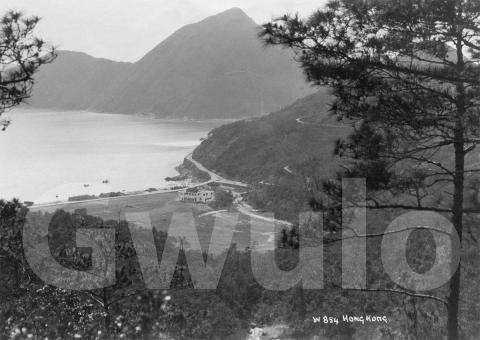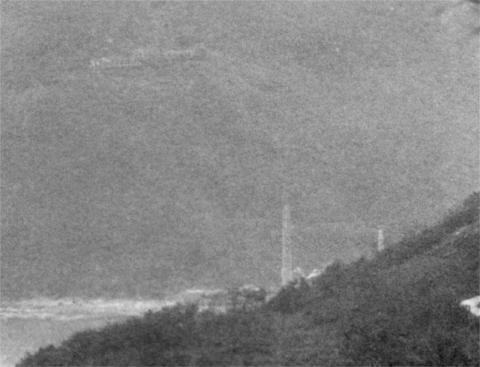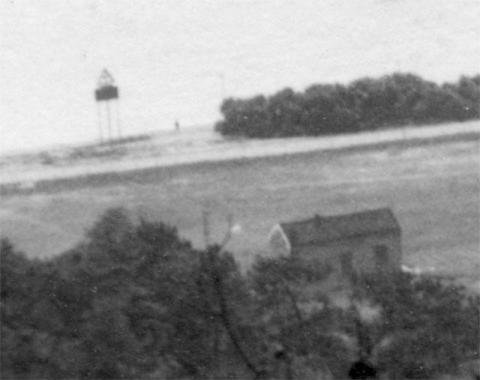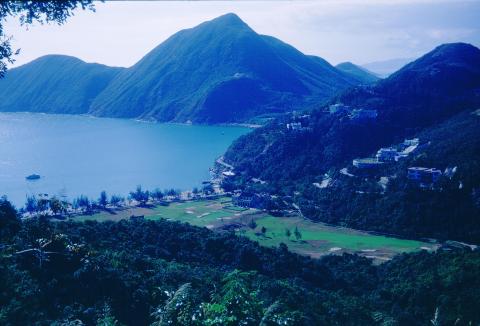Where: You probably recognise this view, but if you're struggling then imagine a line of cable cars running along the distant hillside at top-left. We're looking out over Deep Water Bay towards Brick Hill and the peninsula where Ocean Park has its dolphin shows.
What: Balls, and in particular, golf balls. The flat land behind the beach is home to the Hong Kong Golf Club's 9-hole Deep Water Bay Golf Course.
The earliest mention we've found of golf being played here is from 1897, so it has been a golf course for over 120 years. Not for all of that time though, as there was a brief interlude when the site became a bakery.
In the preparations for war in 1941, the Royal Army Service Corps (RASC) earmarked the golf course for use as a field bakery, producing bread for the armed forces. Its location on the south of the island was considered a relatively safe place to be. Staff-Sergeant Patrick Sheridan was the RASC Master Baker in charge of the field bakery here. Here are some extracts from his diary, starting on the day that war was declared:
8 Dec 1941: "I leave for Deepwater Bay with the first three lorries and some coolies. [...] On arrival at Deepwater Bay whilst some of the coolies unload the lorries, I set others to work building the 1st 10 Aldershot ovens. It seems a shame to dig up the nice green turf on the green in front of the clubhouse. There are no golfers about now. Good progress is made as I use the verandah as my Bakery with all the dough troughs set out in a convenient way.
The Hong Kong Volunteer Defence force have been mobilised. Sgt. Jan ((actually Ernest)) Tuck and Cpl. Bonner report to me and are a great help. Both can speak a fair amount of Chinese. We get the ten ovens erected and fired before dark, also one Perkins coke oven was erected on the verandah. We use army blankets to black out the verandah. It is quite spacious with good room to work, dough making and moulding. The front of the Perkins oven rests on the parapet of the verandah. I am hoping to be able to erect two more the same way. The Aldershot ovens are about 15 yds away from the verandah. We have a good supply of wood and I see no reason why we should not be able to keep the supply of bread to all the troops. We manage to grab some food during the day as best as we can. The coolies have to be given some rice and bread. We keep working until midnight then get down to sleep on the verandah."
11 Dec 1941: "The Bakery is operating efficiently and turning out 14000 lbs of good bread every day. I only hope that it is getting to the men who deserve it i.e. the fighting. I get told off by a Security officer for lighting up the ovens before daylight. I told him it was either that or there would be some people short of their bread ration. I think he understood the situation."
14 Dec 1941: "Just a week ago today I saw the golfers enjoying their round of golf, or sitting on the verandah enjoying their cocktails. Now the grass is cut up by numerous lorries and the green in front of the Clubhouse is marred by the unsightly hump of 15 Aldershot ovens."
((Although the south of the island seemed safer, Deep Water Bay is directly below Wong Nai Chung Gap, where the Japanese focused their attack.))
19 Dec 1941: "No sleep whatever during the continuous firing racket all night. Twice during the early hours we had a stand to. Heavy automatic and rifle fire can be heard from the direction of Wong-Nei-Chong Gap where the Canadians are being attacked. It is only a quarter of a mile away from the Golf club. Before daylight tracer bullets zoom over my Aldershot ovens. I get the bakers on mixing doughs in the shelter of the club house verandah. As soon as it is light we fire up the ovens. There is a lot of mortar explosions from the direction of the Gap. Tracers still go flying past. With the help of Leung Choy we calm the Chinese bakers and keep them working.
Some wounded Naval men limp into the club house. We give them first aid. They had been in a convoy of trucks taking food and ammunition up the Repulse Bay road to the Canadians at the Gap. The convoy had been ambushed by the Japs, some of the sailors had been killed and wounded. We were now in the line of fire, as tracers and mortars began to explode everywhere.
Orders are now given for everyone to be ready to move out at a moment’s notice. The Bakery carries on working until about 10a.m. then we get orders to leave everything and move out at once. I enquire of the Senior officer if we are to take any equipment. The answer is no. Empty lorries, cars, and me all leave like lightning. I dash up to the first floor of the Golf Club to collect some small kit, but when I return I find everyone had left. I take a last look at the doughs in the verandah in the wooden mixing troughs. In a few hours they will be rotten. The makings of about 8000 lbs of good bread gone west."
The golf course's brief time as a bakery had come to an end.
With balls & bread explained, how about the bricks?
If you've ever looked at this area on a map, you'll know that the sharp peak in the background is called Brick Hill. It takes its name from a brickworks that operated at the bottom of the hill. I bought this photo because we get a glimpse of the brickworks' chimneys. Not very sharp, but this was the first time I'd seen any photo of the brickworks.
If you look up at the 11 o'clock direction from the taller chimney, there's also a sign of a low building up on the hillside. We know the superintendent of the works lived on a hill overlooking the bay, so I guess this was his house.
Who: Danes.
We don't have much about information Hong Kong's Danish community on the Gwulo website, so this is a good chance to introduce a Danish company: The Great Northern China and Japan Extension Telegraphic Company. They were part of the communications revolution that hit Hong Kong at the start of the 1870s.
In 1871 the Danes landed Hong Kong's first international telegraph cable, here at Deep Water Bay. It connected Hong Kong and Shanghai - which was good, but the real prize was to enable telegraphic communications with London. A competing company from Britain took first place in that competition, when they landed their cable at Telegraph Bay a few months later. That second cable took a southern route via Singapore, and was the first cable that allowed telegrams to be sent between Hong Kong and London. The Danes persevered however, and from the 1st of January 1872, their northern cable was also able to exchange telegrams with London.
The cables are all out of sight in the photo above, hidden underground or underwater. We know they're there though, from this small building with a pitched roof, peeping out from behind the trees.
Early maps show it marked "cable hut", so this is the building where cable from the sea ended, and was connected to the cables running across land to the Hong Kong offices of the telegraph company. Looking at 10 o'clock from the cable hut there is a sign on the beach. I wondered if it was to warn ships not to anchor here, so they wouldn't damage the cable. Can anyone confirm?
When: The photo must have been taken several decades after those first golf games in 1897. Reports from 1908 say the golf course wasn't very popular as it was difficult to reach. Golfers leaving from Central had to either sail there by launch, or travel over Wong Nai Chung gap by pony or sedan chair.
That all changed in 1915, when the road from Aberdeen to Deep Water Bay via the coastline was completed. (Before that, the road from Aberdeen was the narrow, twisting track we can see climbing the hill to the right of the clubhouse.) In the photo, the new, wider road is already built, and continues alongside the beach. We know that the extension to Repulse Bay was completed in 1917, so the photo was taken after that, too.
The brickworks might help put a limit to the latest year that the photo could have been taken. I've found a newspaper report saying the works were closed at the end of 1927, but it isn't clear if they were demolished soon after, or if they re-opened again. Does anyone know about their later history?
Looking at the cars I'll guess the photo was taken in the 1920s, but corrections are welcomed!
Gwulo photo ID: EM003
Trivia:
#1 Does any part of the old cable hut still remain?
Deep Water Bay is still a landing site for international communications cables, though they now land in the northeast corner of the bay, near to the stream. So there's no longer any need for a cable hut on the golf course's land, but there is still a small building roughly where the old cable hut used to be. It's marked "store" on the modern government maps.
The building can be seen from the road, and one obvious change is that the present building has a flat roof. Is it the original building that has been re-roofed, or a modern building built on the same site? We'd get a better idea if we could see what the building is made of: a concrete hut is definitely modern, but if it was built from stone it could be closing in on its 150th birthday!
If we have any golfers reading, please could you take a look (and photos if possible) when you're next there?
#2 Does any part of the brickworks remain?
I doubt that any of the buildings remain, but there is still a hint of the brickworks' history in the modern Ocean Park site.
Traditionally, a brickworks was built near to the source of its main, heavy ingredient: clay. The brickworks at Brick Hill were no exception, excavating clay on the site. A government report from the CEDD says that the old clay pits were incorporated into today's Ocean Park:
"Along the coast immediately to the southeast of the main Ocean Park development, fine ash tuff [...]. Mudstone crops out nearby, and extends inland where old clay workings in this layer are now part of the ornamental ponds of Ocean Park. This was the site of the Green Island Brick and Tile Works described by Davis (1952) [...]"
#3 The view today
I'll include a 1960s view below, but how does it look today? If you know anyone that lives along Repulse Bay Road and has a similar view to this, please could you ask them to take a photo to show to us?
Further reading: I've linked to relevant pages in the text above, so please click on the links for more facts and photos about the different subjects. Then for collections of more old Hong Kong photos and their stories, please see Volume 1 and Volume 2 of the Gwulo books.






Comments
Underwater Cable Landing Point Sign
@ "Looking at 10 o'clock from the cable hut there is a sign on the beach. I wondered if it was to warn ships not to anchor here, so they wouldn't damage the cable. Can anyone confirm?"
The shape of the sign looks like a standard Marine sign warning of underwater cable landing points .
DWB Golf Club
I was excited to see the photos of the golf club. Bewteen 1950 and 1954 I used to be taken there by a friends family on a Saturday. The parents would play golf and their son and I would swim and play on the beach and in the rocks. For lunch and in the evening we would go up to the verandah bar and have "Club sandwiches" and then scoot back to the beach. Then a tired drive home. I have only had a memory of the Club house and your photos have confirmed it. Thank you.. Stephen Roberts
re: Underwater Cable Landing Point Sign
Thanks Chinarail, good to have the sign's identity confirmed.
re: DWB Golf Club
Stephen, there are few more photos of the club you might enjoy at https://gwulo.com/node/11457/photos
Cable house
Many thanks for this great read, David.
According to "Festina Lente: A History of The Royal Hong Kong Golf Club" published in 1889, the cable house was purchased by the Club in 1958 and was converted into a store room for the greenkeeper's equipment.
The hut is now entirely covered in ivy, but the next time I'm down at DWB (I work at Fanling) I'll have a proper look and take some images.
Thanks,
Alex
Great Dane
The man who laid Hong Kong cables can be read here
Golf Club and Cable House
@ According to "Festina Lente: A History of The Royal Hong Kong Golf Club" published in 1889, the cable house was purchased by the Club in 1958 "
Amazing foresight .
A typo in the date no doubt ?
1989!
Ha. Yes, should have been 1989. The Hong Kong Golf Club itself was established in 1889. Whoops.
re: Cable house
Thanks Alex, fingers crossed there is some evidence that it's the old building.